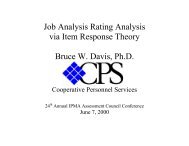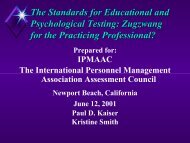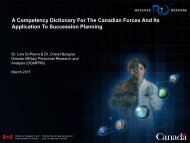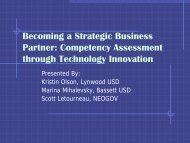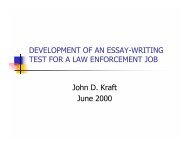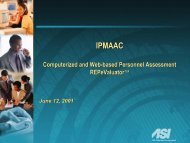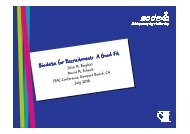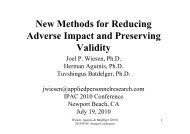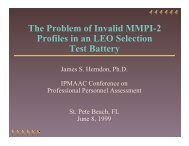Employment Testing of Persons with Diasabling Conditions - IPAC
Employment Testing of Persons with Diasabling Conditions - IPAC
Employment Testing of Persons with Diasabling Conditions - IPAC
Create successful ePaper yourself
Turn your PDF publications into a flip-book with our unique Google optimized e-Paper software.
What is the solution to this problem? Time lijnits for regular tests<br />
should be liberal enough so that 90% or 95* <strong>of</strong> applicants finish the test.<br />
Unlimited time can then be given to disabled applicants who need extra time.<br />
In large-scale testing operations, it may be possible to establish time limits<br />
empirically, as recommended by the APA standards. For similar item-types,<br />
multipliers developed at OPM' for visually handicapped applicants on the<br />
Pr<strong>of</strong>essional and Administrative Career Examination (PACE) might be used:<br />
For questions which consisted <strong>of</strong> a single paragraph followed by five<br />
answer choices, the multipliers were as follows:<br />
Large Print 1.7 - 2.4<br />
Braille 2.1 - 3.3<br />
Audiotape 2.0 - 2.9<br />
Reader 2.4 - 2.6<br />
(NOTE: A range <strong>of</strong> values is given because there were three such test<br />
parts, each <strong>of</strong> which had a different requirement.)<br />
For quantitative items which had extensive computational requirements<br />
(electronic calculators not permitted), the multipliers were:<br />
Large Print 5.0<br />
All other media 7.0<br />
The multipliers for the quantitative test are probably somewhat inflated<br />
because this test part was somewhat speeded for the non-disabled<br />
competitors. However they show that considerable extra time is needed<br />
for items which require computation.<br />
Content change is potentially more controversial than time limit change,<br />
except that it does not occur very <strong>of</strong>ten. Three degrees <strong>of</strong> content change are<br />
given in Table 2. The first, changing an item, could be as simple as<br />
substituting one item for another in a construct-based test, which would have<br />
no effect on validity. Translation into sign language is a far more complex<br />
change, but it retains the same item-type. An item-type change would occur if<br />
another item-type was used to test the same ability, as was done on PACE.<br />
This would occur most readily in a construct-based test. Finally, there is<br />
the radical step <strong>of</strong> KSA change or deletion. This would be justified only if<br />
there is no way to test the intended knowledge, skill, or ability and if there<br />
■Nester, 1984<br />
- 6 -



